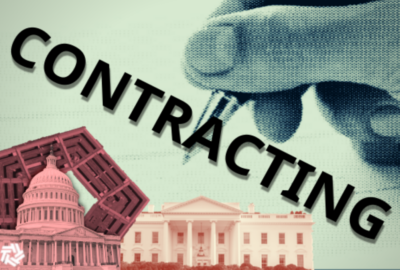Hubbard Radio Washington DC, LLC. All rights reserved. This website is not intended for users located within the European Economic Area.
With a lot to chase in 2024, fewer federal contractors are chasing an increasing number of federal dollars
For the big federal contracts on the horizon in 2024, not a whole lot is changing when it comes to what the government plans to buy. But there are still a lot o...
For the big federal contracts on the horizon in 2024, not a whole lot is changing when it comes to what the government plans to buy. But there are still a lot of opportunities for contractors, as agencies re-compete some of their biggest buying vehicles. Those are some of the takeaways from Deltek’s annual list of top contracting opportunities. Ashley Sanderson is a senior research manager at Deltek. She joined Federal Drive Deputy Editor Jared Serbu to talk more about the 2024 edition on the Federal Drive with Tom Temin.
Interview Transcript:
Jared Serbu Ashley, thanks for joining us. And before we delve into some of the top opportunities that you all identified this year, I’d like to spend a little bit of time talking about some of the trends that you talk about in the report as well, starting with overall contracting spend. What have you been seeing over the last several years as you’ve examined the data?
Ashley Sanderson The contracting spend has gone. It went down in 2021, as we saw, but it has been growing. We do not know contract spend history in a full view right now for fiscal year 2023 because of the delay of DoD reporting. So that’ll be out at the end of December. But what we do see is that there is some growth from fiscal year 2021 into fiscal year 2022. I think we’re spending roughly a little under 700 billion in contracts then for fiscal year 2022. The importance of that is it kind of helps us have an idea of what we’re looking at for the coming fiscal year. And if there’s more contract spend, there tends to be more activity, there’s less delays, less slows, less cancellation of requirements because it seems like they’re spending. This year may be interesting because we are going in under a continuing resolution. We also have what’s coming up in January and February. So I would predict despite the spending, boding pretty well for fiscal year 2024, that it’s not going to be immediate. It’s probably going to be a slow uptick.
Jared Serbu Yeah. And to that point, there are so many unknowns about the coming fiscal year. It would be unwise to make too specific predictions about it. But one thing that you did is took a look at what we know about the effect of past years in which we’ve had CRs and how that tends to affect quarterly spend. Tell us a bit about that, because it’s probably instructive, at least to some extent, for what’s going to happen in 24.
Ashley Sanderson Yeah. So what we see with past years when we look at quarterly spending is spending tends to really happen more towards the end of the year. You’re seeing more happening in Q3 and Q4 when it comes to quarterly spend. About 19 to 21% of annual spend happened when operating under the continuing resolution. And then you see the rest of it happening once everything’s actually passed in their appropriations. 2019 is that weird outlier because we had partial appropriations that were approved at the beginning of the fiscal year for Labor, HHS. And there you see spending. Nobody else was spending until later in the year when the second round of appropriations happened in February, which is what we may be looking at right now potentially.
Jared Serbu And then last thing I wanted to ask you about in terms of overall trends was participation in contracting looks like a lot more dollars, but fewer companies, basically, right?
Ashley Sanderson Absolutely. Absolutely. That’s definitely what we’re seeing. But it’s nothing to be discouraged about. But it is a trend that we’re seeing due to some outlying factors. There’s the category management push, right? So they’re trying to consolidate more. They are trying to remove duplicative efforts. Everything’s supposed to be streamlined. Because of that, what we see is the government is doing a lot more consolidation in their contracts. They are choosing to procure things under already existing contracts. They’re not having these new competitions as much anymore. The other thing that we’re seeing is there is a lot more compliance regulations that are coming out, right? You have CMMC now. I was doing a report a back a while about the infrastructure bill. So if you look at architecture, engineering and construction requirements, there’s a lot more that’s coming out now with the infrastructure bill where you have to use particular materials. You have to do a particular practice. It has to be renewable. So all of those things, while great, are also expensive for vendors. So it does kind of push some vendors out to, you know, maybe not be able to participate or it’s just slower on the uptake because they have to get all of this compliance under their belt prior to even being able to compete.
Jared Serbu And then when it comes to the meat of the report, which is the top opportunities for 24, I mean, I’ll just say that this is better suited for reading than audio consumption so people can read it on your website. But let’s try and do a summary if we can. What jumps out at you when you look at those top opportunities for 24? What’s most what’s most interesting? Let’s try and summarize a bit if we can.
Ashley Sanderson So what’s interesting about this year’s report is that it is a pretty even mix. It’s about half and half defense and civilian, which we have been seeing for the past few years. Long time ago, we used to see a lot more heavyweight and defense opportunities. But slowly, it sort of moved into where there’s more civilian heavyweights in there. Part of that has to do with the lack of new requirements coming out as frequently. We’re also seeing that there are re-competes and there’s actually only one new requirement on the list. That’s a new requirement for our construction opportunity for the Department of Navy. It’s building a building. So of course, there’s no incumbent on that. It’s new construction. Every single other requirement is a requirement that they have procured in the past, and it already has vendors who are working on it now that can be looked at sometimes as a negative aspect. Right. Because it might be harder to get in on these contracts. You think there’s someone who already has their footing. Someone always has been doing this work. However, there’s a benefit maybe, right. You can glean a lot of information from historical information then. Right? You have access to past solicitations. You can look at past performance. You can see where the money is going, who’s getting these task orders, who’s not. And to sort of bring that together with what we were talking about earlier with the category management stuff and then sort of streamlining and have fewer and fewer new requirements. A good way around that is subcontracting, right. So even if you can’t get into prime, you can get into subcontract on a lot of these larger requirements.
Jared Serbu Right. And all of these are unrestricted, right? There’s going to be more opportunities that are that are set aside. But these are each one of these is unrestricted.
Ashley Sanderson Each one of these is unrestricted, which is important just to take a step back. So the report that I particularly do is the top 20 unrestricted. We do have three additional reports. We have a top ten small business report which solely focuses on the small business kind of requirements. We also focused a top ten report on professional services on that industry, primarily because it does tend to dominate this top 20 list since it tends to have the most money. So we have a professional services. We also have an architecture, engineering and construction list that is a top ten list as well. And all of those are put together in a similar fashion. So we’re looking specifically at what requirements are going to be coming out specifically in fiscal year 2024 if they’re sort of a bellwether requirement, that helps us get an idea of what the trend is moving forward for that year and beyond. And then also we’re looking at obviously, how much the estimated value is, be it from past spending or from total estimated ceiling and using that sort of higher value opportunities.
Jared Serbu So actually, getting back to your point about there really not being that many new requirements here, is that a negative sign for companies this year?
Ashley Sanderson I don’t think so at all. I would definitely keep a positive outlook. There is still money to be spent here. These contracts are worth millions of dollars. The government is still going to be spending money. Right. Where you may want to step back is if there are not as many new requirements, there’s not as many things going on. There is a slowdown because of the continuing resolutions. So take your time. Get familiar with the compliance requirements. Be smart about what you are going to pursue. Get to know your customer and exactly what they’re looking for. And like we said earlier, with the consolidation, get familiar with subcontracting and how to do that, looking to teeming opportunities and certainly not a time to be discouraged. It just might take a little bit more legwork right now.
Copyright © 2024 Federal News Network. All rights reserved. This website is not intended for users located within the European Economic Area.
Jared Serbu
Jared Serbu is deputy editor of Federal News Network and reports on the Defense Department’s contracting, legislative, workforce and IT issues.
Follow @jserbuWFED
Related Stories
Exclusive
Acquisition Policy
Read more
Keeping fingers crossed about a potential government shutdown, contractors have a new White House initiative to scrutinize
Related Topics





